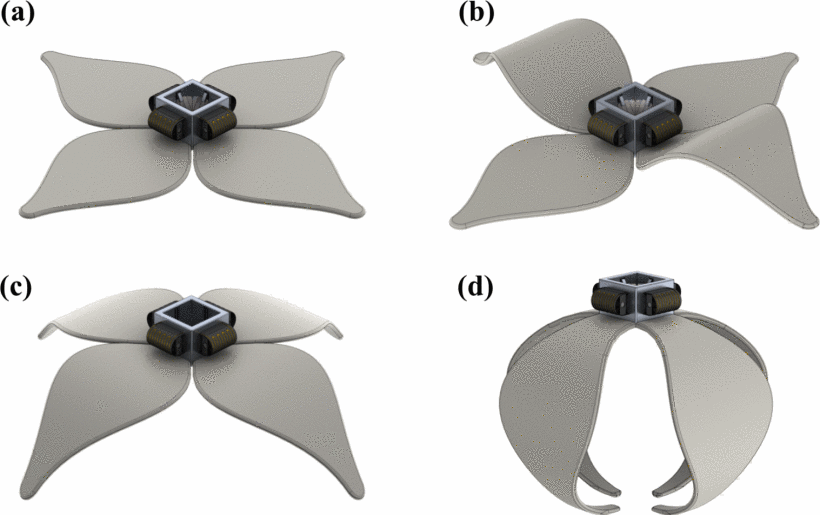Area-of-effect softbots (aoes) for asteroid proximity operations

This paper will provide an introduction and overview of Area-of-Effect Softbots (AoES), which are currently in development under a Phase 2 NASA Innovative Advanced Concepts (NIAC) project. AoES are designed to operate in proximity to, and on the surface of, small asteroids to support mining and planetary defense missions. Their unique design and capabilities are dependent on the incorporation of soft, compliant, and lightweight materials. AoES have a large area-to-mass ratio which allows them to take advantage of the peculiarities of the dynamical environment around small asteroids. Specifically, AoES will use solar radiation pressure to sail to the surface of the target asteroid after being deployed at a safe altitude from a mothership around the asteroid. This capability and the associated control laws will be demonstrated, removing the need for propulsion systems. Furthermore, the large, flexible surface area allows for robustness with respect to uncertainty about the asteroid surface structure - it can provide flotation to prevent sinking into a very loose, dusty regolith, and also provide anchoring to the surface through natural and electroadhesion forces. The enabling technology that will allow the AoES design loop to close is a new class of soft actuators known as HASEL actuators. These actuators harness an electrohydraulic mechanism, whereby electrostatic forces generate hydraulic pressure to drive shape change in a soft fluidfilled structure. HASELs provide an extremely power- and mass-efficient mechanism for actuating the large flexible surface areas that are the essential components defining AoES. Current system design, requirements, and key tradeoffs will be discussed - with a particular focus on the actuation, mobility, anchoring, materials, and power systems/components. The nominal mission profile and concept of operations for using
| Author(s): | Jay McMahon and Shane K Mitchell and Kenshiro Oguri and Nicholas Kellaris and Donald Kuettel and Christoph Keplinger and Benjamin Bercovici |
| Book Title: | 2019 IEEE Aerospace Conference (AERO 2019) |
| Pages: | 1554--1569 |
| Year: | 2019 |
| Publisher: | IEEE |
| Bibtex Type: | Conference Paper (inproceedings) |
| Address: | Piscataway, NJ |
| DOI: | 10.1109/AERO.2019.8741680 |
| Event Name: | IEEE Aerospace Conference (AERO 2019) |
| Event Place: | Big Sky, MT |
| State: | Published |
| URL: | https://ieeexplore.ieee.org/stamp/stamp.jsp?arnumber=8741680 |
| Electronic Archiving: | grant_archive |
| Institution: | IEEE |
| ISBN: | 978-1-5386-6855-9 |
BibTex
@inproceedings{Keplinger19-IEEE-Softbots,
title = {Area-of-effect softbots (aoes) for asteroid proximity operations},
booktitle = {2019 IEEE Aerospace Conference (AERO 2019)},
abstract = {This paper will provide an introduction and
overview of Area-of-Effect Softbots (AoES), which are currently in development under a Phase 2 NASA Innovative
Advanced Concepts (NIAC) project. AoES are designed
to operate in proximity to, and on the surface of, small
asteroids to support mining and planetary defense missions.
Their unique design and capabilities are dependent on the
incorporation of soft, compliant, and lightweight materials.
AoES have a large area-to-mass ratio which allows them
to take advantage of the peculiarities of the dynamical
environment around small asteroids. Specifically, AoES
will use solar radiation pressure to sail to the surface of
the target asteroid after being deployed at a safe altitude
from a mothership around the asteroid. This capability and
the associated control laws will be demonstrated, removing
the need for propulsion systems. Furthermore, the large,
flexible surface area allows for robustness with respect to
uncertainty about the asteroid surface structure - it can
provide flotation to prevent sinking into a very loose, dusty
regolith, and also provide anchoring to the surface through
natural and electroadhesion forces.
The enabling technology that will allow the AoES design
loop to close is a new class of soft actuators known as
HASEL actuators. These actuators harness an electrohydraulic mechanism, whereby electrostatic forces generate
hydraulic pressure to drive shape change in a soft fluidfilled structure. HASELs provide an extremely power- and
mass-efficient mechanism for actuating the large flexible
surface areas that are the essential components defining
AoES. Current system design, requirements, and key tradeoffs will be discussed - with a particular focus on the
actuation, mobility, anchoring, materials, and power systems/components. The nominal mission profile and concept
of operations for using},
pages = {1554--1569},
publisher = {IEEE},
institution = {IEEE},
address = {Piscataway, NJ},
year = {2019},
slug = {keplinger19-ieee-softbots},
author = {McMahon, Jay and Mitchell, Shane K and Oguri, Kenshiro and Kellaris, Nicholas and Kuettel, Donald and Keplinger, Christoph and Bercovici, Benjamin},
url = {https://ieeexplore.ieee.org/stamp/stamp.jsp?arnumber=8741680}
}
